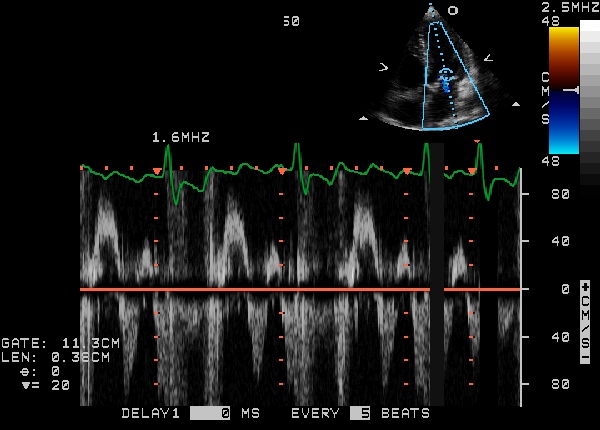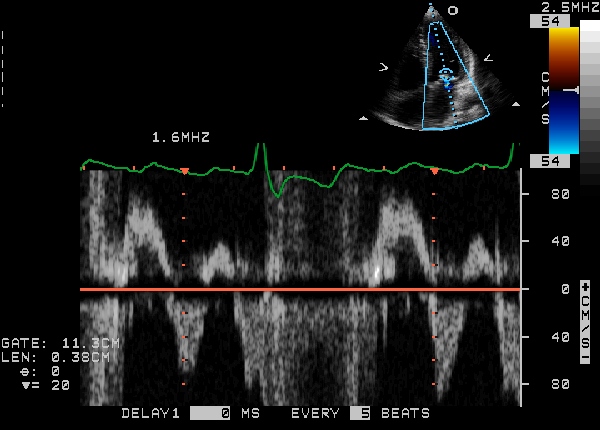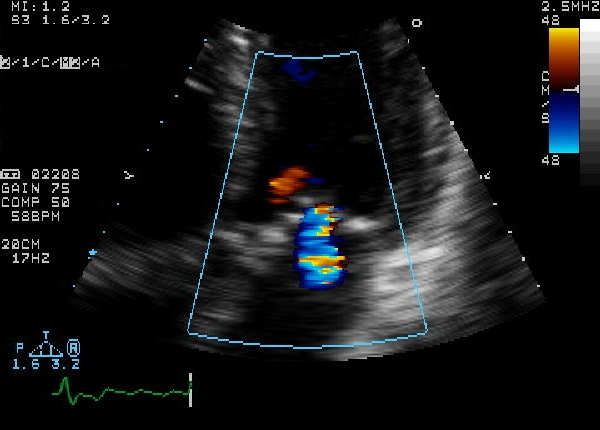Mitral regurgitation assessment of severity
|
Mitral Regurgitation Microchapters |
|
Diagnosis |
|---|
|
Treatment |
|
Case Studies |
|
Mitral regurgitation assessment of severity On the Web |
|
American Roentgen Ray Society Images of Mitral regurgitation assessment of severity |
|
Risk calculators and risk factors for Mitral regurgitation assessment of severity |
Editor-In-Chief: C. Michael Gibson, M.S., M.D. [1]; Associate Editor(s)-In-Chief: Cafer Zorkun, M.D., Ph.D. [2]; Varun Kumar, M.B.B.S. [3]; Lakshmi Gopalakrishnan, M.B.B.S. [4]
Overview
The severity of MR can be assessed by both clinical and echocardiographic criteria. Careful history is important to establish an estimate of baseline exercise tolerance of the patient.
The 2006 ACC/AHA guidelines included recommendations for echocardiographic monitoring in asymptomatic patients with chronic MR [1]. Echocardiography is performed to assess the left ventricular ejection fraction and end-systolic dimension.
| Degree of mitral regurgitation | Regurgitant fraction | Regurgitant Orifice area |
|---|---|---|
| Mild mitral regurgitation | < 20 percent | |
| Moderate mitral regurgitation | 20 - 40 percent | |
| Moderate to severe mitral regurgitation | 40 - 60 percent | |
| Severe mitral regurgitation | > 60 percent | > 0.3 cm2 |
Assessment of Severity of Mitral Regurgitation
The degree of severity of mitral regurgitation can be quantified by the percentage of the left ventricular stroke volume that regurgitates into the left atrium (the regurgitant fraction).
Methods that have been used to assess the regurgitant fraction in mitral regurgitation include:
- Echocardiography.
- Cardiac catheterization.
- Fast CT scan.
- Cardiac MRI.
The echocardiographic technique to measure the regurgitant fraction is to determine the forward flow through the mitral valve (from the left atrium to the left ventricle) during ventricular diastole, and comparing it with the flow out of the left ventricle through the aortic valve in ventricular systole.
This method assumes that the aortic valve does not suffer from aortic insufficiency. The regurgitant fraction would be described as:
Regurgitant fraction = { (Vmitral - Vaortic) ÷ Vmitral } x 100% where Vmitral and Vaortic are respectively the volumes of blood that flow forward through the mitral valve and aortic valve during a cardiac cycle.
Another way to quantify the degree of mitral regurgitation is to determine the area of the regurgitant flow at the level of the valve. This is known as the regurgitant orifice area, and correlates with the size of the defect in the mitral valve.
One particular echocardiographic technique used to measure the orifice area is measurement of the proximal isovelocity surface area (PISA). The flaw of using PISA to determine the mitral valve regurgitant orifice area is that it measures the flow at one moment in time in the cardiac cycle, which may not reflect the average performance of the regurgitant jet.
Colour Flow Mapping
- Size of flow recruitment is noted.
- Jet base width at the valve level.
- Intra atrial jet area if it is a central jet.
- Jet direction is usually away from a prolapsing leaflet and behind a restricted leaflet.
Continuous Wave Doppler
- Shape and density of signal - In severe Mitral regurgitation, the flow is dense and triangular.
- If as dense as forward flow, it is severe.
Pulse Wave Doppler(PW)
- PW in apical-4-chamber view.
- E wave more than 1.2m/s indicates severe MR.
- Even minor mitral stenosis or hyperdynamic circulation can increase E wave.
- If A-wave dominant, severe MR is virtually ruled out.
Vena Contracta
- vena contracta is the narrowest region of regurgitant jet (usually just below the valve in LA).
- >0.7 cm - severe MR.
Pulmonary Venous Flow
- Usually forward throughout cycle.
- Systolic dominant.
- As MR worsens, there is a blunting of systolic flow.
- If severe MR - systolic flow reversal.
Regurgitant Volume
- Mitral regurgitant volume = Mitral inflow volume - LV outflow volume.
- Mitral inflow volume = Vti * Cross sectional area of mitral valve.
- LV outflow volume = Vti * Cross sectional area at LV outflow.
- Regurtitant volume - <20% - mild , >50% severe
PISA (Proximal Isovelocity Surface Area)
The radius of Proximal isovelocity surface area or flow convergence zone which is a 3-dimensional surface area proximal to a narrowed orifice at which all the blood velocities are equal, can be used to calculate the severity of mitral regurgitation. The principle is that if the mitral regurgitation is mild, only the blood nearer to the valve orifice accelerates towards the atrium while in severe regurgitation, blood farther away from the valve moves back.
PISA radius
A simple method to determine severity of mitral regurgitation is to measure the PISA radius. Regurgitation is mild if radius is <0.4 cm and severe if >1 cm.
Regurgitant Flow (Instantaneous)
The instantaneous regurgitant flow can be calculated from the PISA radius and can be used to assess the severity of mitral regurgitation.
Regurgitant flow = 2π * r2 * Valiasing
Effective Regurgitant Orifice Area (EROA)
Effective regurgitant orifice area can be calculated using the instantaneous regurgitant flow. The formula can be derived from the following:
Valiasing * 2πr2 = Vmax * EROA
hence:
- EROA = PISA (2πr2) * Valiasing / Vmax
Mild = 0-20 cm2, moderate = 20 - 40 cm2, severe = >40 cm2
Regurgitant volume can be calculated from this.
- Regurgitant volume = Effective regurgitant orifice area * Vtime integrale
Diastolic Mitral Regurgitation Secondary to Severe Aortic Stenosis



{{#ev:youtube|wzYVcqVLspw}}
{{#ev:googlevideo|424719160215823743&hl=en}}
{{#ev:googlevideo|-1316686479831791521&hl=en}}
Severity (Summary)
| Severity | mild | severe |
|---|---|---|
| Jet area | <4 cm2 | >8 cm2 |
| Jet width | thin | >0.6 |
| vena contracta | <0.3 | >0.7 |
| PISA radius | <0.4 | >1 |
| Pulmonary venous flow | systolic dominant | systolic flow reversal |
| Mitral inflow | can be A wave dominant | E wave dominant >1.2m/s |
| Continuous wave doppler | soft and parabolic | dense and triangular |
| LV and LA | normal size | enlarged (in chronic MR) |
| duration | can be short | holosystolic |
| Regurgitant volume | <30 ml | >60 ml |
| EROA | 0-20 cm2 | >40 cm2 |
References
- ↑ Bonow RO, Carabello BA, Chatterjee K, de Leon AC, Faxon DP, Freed MD; et al. (2008). "2008 Focused update incorporated into the ACC/AHA 2006 guidelines for the management of patients with valvular heart disease: a report of the American College of Cardiology/American Heart Association Task Force on Practice Guidelines (Writing Committee to Revise the 1998 Guidelines for the Management of Patients With Valvular Heart Disease): endorsed by the Society of Cardiovascular Anesthesiologists, Society for Cardiovascular Angiography and Interventions, and Society of Thoracic Surgeons". Circulation. 118 (15): e523–661. doi:10.1161/CIRCULATIONAHA.108.190748. PMID 18820172.